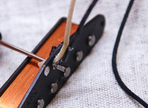
Soldering Basics for Guitar Players - Part 1
Soldering Equipment for Beginners

 Print
Print |
Soldering Basics for Guitar Players - Part 1 |
 |
| By FloSon on 06/22/2014 |  Print Print |
|
Using the first soldering iron you find in your way may be OK for a one-time job, but it won't necessarily be the best suited to the task at hand. If you limit yourself to electric guitar (and bass) solder joints, the ideal temperature to make tin boil without burning the contacts is around 360 degrees. Basic irons need some time until they reach this temperature, but they can go up to 450º and, some of them, even higher. Since there's no need for you to put your hands on the iron to see if it has reached the right temperature, and most probably you don't have a thermometer that can read such temperatures, you can buy an iron with a built-in thermostat, like this one, for example. Finally, if you are looking for the best quality, you should go for Weller, the undisputed leader in this regard, like Facom when it comes to equipment.
The other crucial factor to get impeccable solder joints is the tin employed. It's best to buy "SN 60" solder (which has 40% lead and, thus, should be kept away from children, who might get intoxicated if they put it in their mouths), whose price is negligible, considering the service it will provide.
If you want to solder something fast or renovate your instrument completely, a soldering iron and solder won't be enough. You will also need:
You could obviously add lots of other accessories to the list, but the above ought to be enough in most cases.
Now that we've reviewed the equipment, in the second part of this series we'll show you how to use all these nice little things with a practical example.
Reproduction and distribution rights reserved © Audiofanzine 2024.
For personal use only. The user of the site acknowledges that he has read and accepts the general terms of use and that he will respect them.